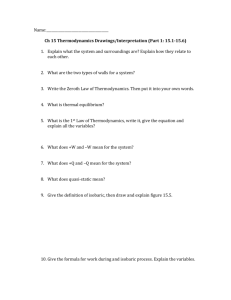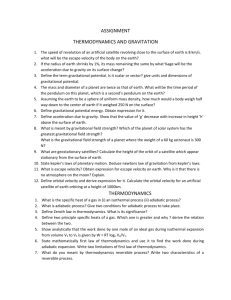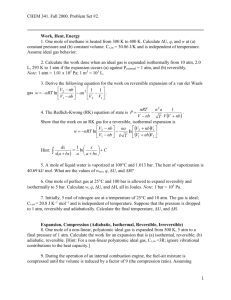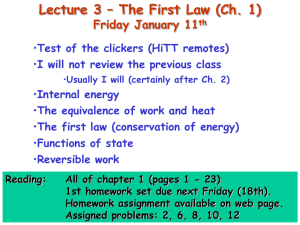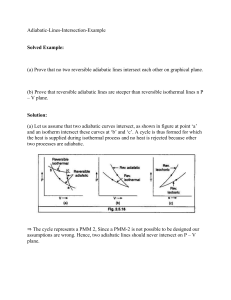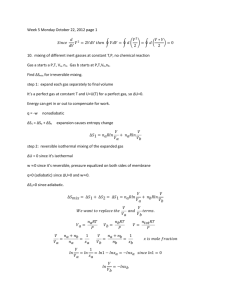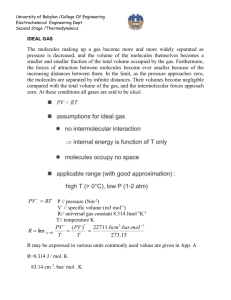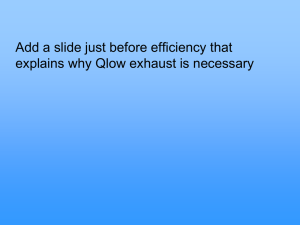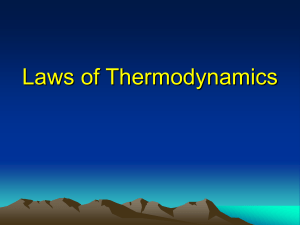V) T
advertisement
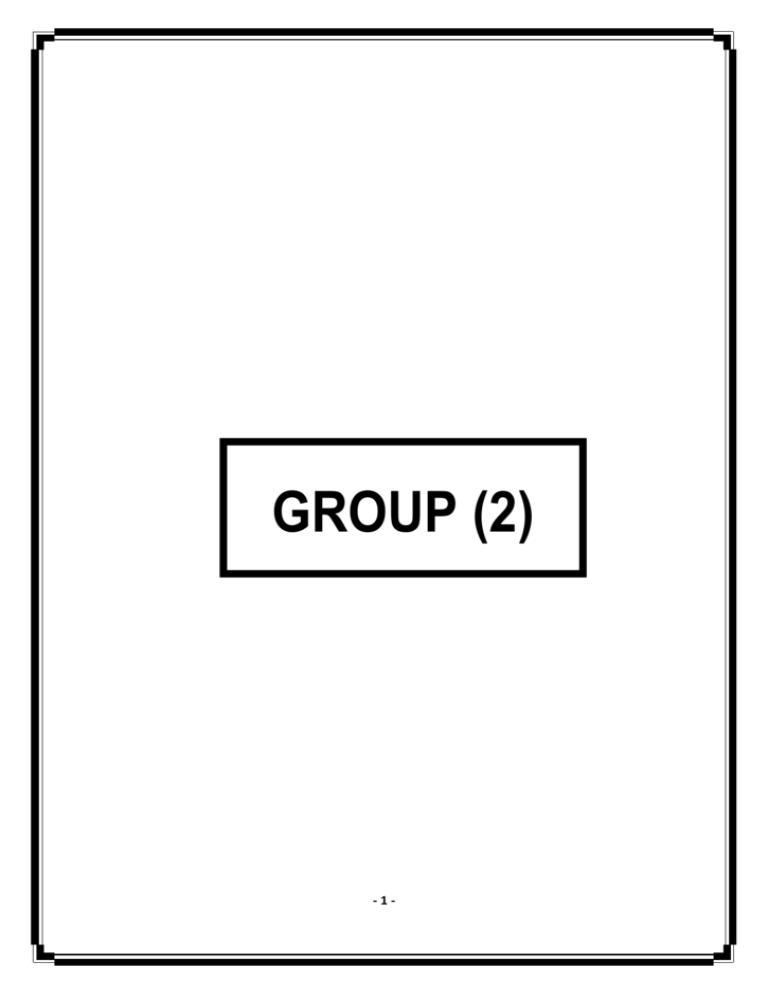
GROUP (2) -1- 2.3 Internal Energy and the First Law of Thermodynamics The development of thermodynamics from its early beginnings to its present state was achieved as a result of the definition of convenient thermodynamic functions of state. In this section the first of these functions, the internal energy U, is introduced. Joule’s experiments resulted in a statement that “the change of a state of a body inside an adiabatic enclosure from a given initial state to a given final state involves the same amount of work by whatever means the process is carried out” This statement is a preliminary formulation of the“First Law of Thermodynamics” and it is similar to the following relations: w = potential energy of body m at position 2 (mgh2) - potential energy of body m at position 1 (mgh1) for a body of mass m when lifted in a gravitational field, g, from height h1 to height h2 (where w is the work done on the body); and also when a particle with charge q, is moved in an electric field from point at potential Ø1, to point at potential Ø2, the work done, w, on the charged particle is given as, w=electric energy at point 2 (qØ2) – electric energy at point 1 (qØ1) It is possible to write, for the Joule adiabatic process in which w is done on a body, as a result of which its state moved from state A to state B: w=UB-UA -2- In describing the sign of work in this case, w will be positive by convention, if the work is done on the system, thus UB > UA , and w will be negative if the work is done by the system, i.e. UB <UA In Joule’s experiment, the change in the state of the adiabatically contained water was measured as a temperature of the water. The same temperature rise, and hence the same change of state, could have been produced by placing the water in a thermal contact with a source of heat and allowing heat q to flow into the water. In describing the sign of q, it is by convention to assign a positive value for q if heat flows into the body (endothermic process) and negative value for q if heat flows out of the body (exothermic process); hence. q = (UB –UA). Now for a body which absorbs heat q and work w is performed on it, it is possible to show that: ∆U = q + w → (1) Let us first consider that a thermodynamic system changes its state A to state B` as a result of heat flow q from a heat reservoir to the system, then: q = UB’ – UA If the body is adiabatically isolated, i.e. the path is defined, the work w done on the system causes a change from state UB` to state UB, thus: w = UB - UB` Therefore : q + w = (UB` - UA) + (UB - UB`) = UB - U A or : ∆U = q + w For infinitesimal changes, we can write: dU = δq + δw → (2) -3- Equations (1) and (2) represents the mathematical statements of the First Law of Thermodynamics. -4- Figure (2.1): the P-V relation obtained in different pathes (a,b,and c ) -5- From figure(2.1) it can be noticed that: ∆U = U2 – U1 regardless of the path followed. On the other hand, W= is dependent on the path; i.e. w is not a state function because it is path dependent; q is also a path dependent and accordingly it is not a state function. Since U is a state function; thus: U = U (P, V) = U (P, T) = U (V, T) Therefore, the complete differentials of U in terms of its partial derivatives are given by: dU = (∂U/∂P)V dP + (∂U/∂V)P dV = (∂U/∂P)T dP + (∂U/∂T)P dT = (∂U/∂V)T dV + (∂U/∂T)V dT Also, we have: and: i.e. the cyclic integral equals zero 2.4 Constant – Volume Processes Since δw = - Psur dv, then δw = 0 for constant – volume process; and from the First Law of Thermodynamics, we have : dU = δqv and by integration we have: ΔU = qv -6- 2.5 Constant – Pressure Processes & Definition of Enthalpy (H) If the pressure of the system maintained constant during a process which takes the system from state 1 to state 2, and if the process is reversible ,i.e. Psur = Pgas = P, then the work done by the system is given as : then: ΔU = qp + [-P(V2 – V1)] or: qp = (U2 + PV2) – (U1 + PV1) As the expression (u + pv) contains only state functions, then the expression itself is a state function; this expression is termed the enthalpy, H, thus : H = U + PV Hence, for a constant pressure process, qp = ΔH 2.6 Heat Capacity The heat capacity C of a system is the ratio of the heat added or withdrawn from the system to the resultant change in the temperature of the system, then: C = q / ΔT or, for infinitesimal change: -7- C = δq / ∂T The concept of heat capacity is only used when the addition of heat to or withdrawal of heat from the system produces a temperature change; thus, the concept is not used when the process is isothermal or when a phase change occurs. The change of temperature of a system from T1 to T2 due to the addition of a certain quantity of heat to the system is not complete thermodynamic statement since the state of a system is defined by two independent variables; thus, this second independent variable could be varied in a specified manner or could be maintained constant during the change. Thus, we define the heat capacity term either at constant volume, Cv, or at constant pressure, Cp as follows: Cv = (δq/∂T)v Cp = (δq/∂T)p The heat capacity as defined is an extensive function; however, by defining the specific heat capacity as the heat capacity of the system per gram, or the molar heat capacity ( heat capacity per mole); thus, the heat capacities per unit quantity of the system are intensive functions. Since: Cv = (δq/∂T)v thus: Cv = (∂U/∂T)v or : dU = Cv dT Also, as: Cp = (δq/∂T)p thus: Cp = (∂H/∂T)p or : dH = Cp dT It is expected that, for any substance, Cp will be of greater magnitude than Cv since the heat required to increase the body in temperature by one degree involves the amount of heat -8- required to cause expansion of the body against constant pressure per degree of temperature increase. The relation between Cp and Cv (Cp – Cv) can be calculated as follows: Cp – Cv = (∂H/∂T)p – (∂U/∂T)v = (∂U/∂T)p + P (∂V/∂T)p - (∂U/∂T)v As: U= f (V, T) then: ∂U= (∂U / ∂V)TdV + (∂U / ∂T)vdT thus: (∂U/ ∂T)p= (∂U/ ∂V)T (∂V / ∂T)p +(∂U / ∂T) so: Cp – Cv = (∂U /∂ V)T (∂V/ ∂T)p +(∂U/ ∂T)v +P (∂V/∂ T)p – (∂U/ ∂T)v Cp – Cv = (∂V/∂T)p (P + (∂U/∂V)T) Joule's proved through experimentation that (∂U/ ∂V)T = 0 for ideal gases; thus 1. Cp – Cv =P (∂V/ ∂T)p =P ∂/∂T [(RT/P)p] =R 2. For ideal gases : U=f(T) since (∂U/∂V)T = 0 Joule's experiment involved two copper vessels; one is filled with a gas at some pressure connected to a similar evacuated vessel via a stopcock. The two-vessels system was immersed in a quantity of adiabatically contained water; the stopcock was then opened, thus allowing free expansion of the gas into the evacuated vessel. After this expansion, Joule could not detect any change in the temperature of the system. As the system was adiabatically contained and no work was performed; Then, from the First Law of Thermodynamics: ΔU = 0 and hence: dU=(∂U /∂V)T dV + (∂U/∂T)vdT = 0 since dT = 0, and dV≠0, thus (∂U /∂V)T = 0, i.e. the Internal energy of a perfect gas is not function of volume (and hence pressure); it is function only of temperature. -9- The reason for Joule's not observing a temperature rise in the original experiment was that the heat capacity of the copper vessels and the water was considerably greater then the heat capacity of the gas ; thus, the small heat changes which might occurr in the gas were not absorbed in the copper vessels and the water. The Cp-Cv relation is thus given by : Cp- Cv = P (dV/dT)p +(dU/dV)T (dV/dT)p The term P (∂V/∂T)p represents the work done by the system per degree rise in temperature due to expanding against the constant pressure P acting on the system. The term (∂U/ ∂V)T (∂V/∂T)p represents the work done per degree rise in temperature in expanding against the internal cohesive forces acting between the particles of the substance. Thus, for perfect gases the value of (∂U /∂V)T (∂V/∂T)p = 0,for real gases the magnitude of P (∂V/∂T)p is much greater then the value of (∂U /∂V)T (∂V/∂T)p which approaches the zero value, and for condensed phase , the magnitude of (∂U /∂V)T ( ∂V/ ∂T)p is much greater than the value of P(∂V/∂T)p which approaches the zero value. 2.7 Reversible Adiabatic Processes for an Ideal Gas In a reversible adiabatic process for an ideal gas the value of q=0. Thus from the First Law of Thermodynamics and by using the equation of state of the ideal gases, we can show that: - 10 - where: γ = cp /cv 2.8 Reversible Isothermal Processes As dT= 0, then dU= 0; accordingly: δq= -δw = p dV thus: q= -w = RT ln(V2/V1)= RT ln(p1/p2) The P-V relations for a reversible isothermal process and a reversible adiabatic process are shown on the P-V diagram of figure (2.2) in which it is seen that, for a given pressure decrease, the work done by the reversible isothermal process exceeds that done by the reversible adiabatic process. - 11 - Figure(2.2): the P-V diagram for an isothermal and adiabatic proceses. - 12 -


